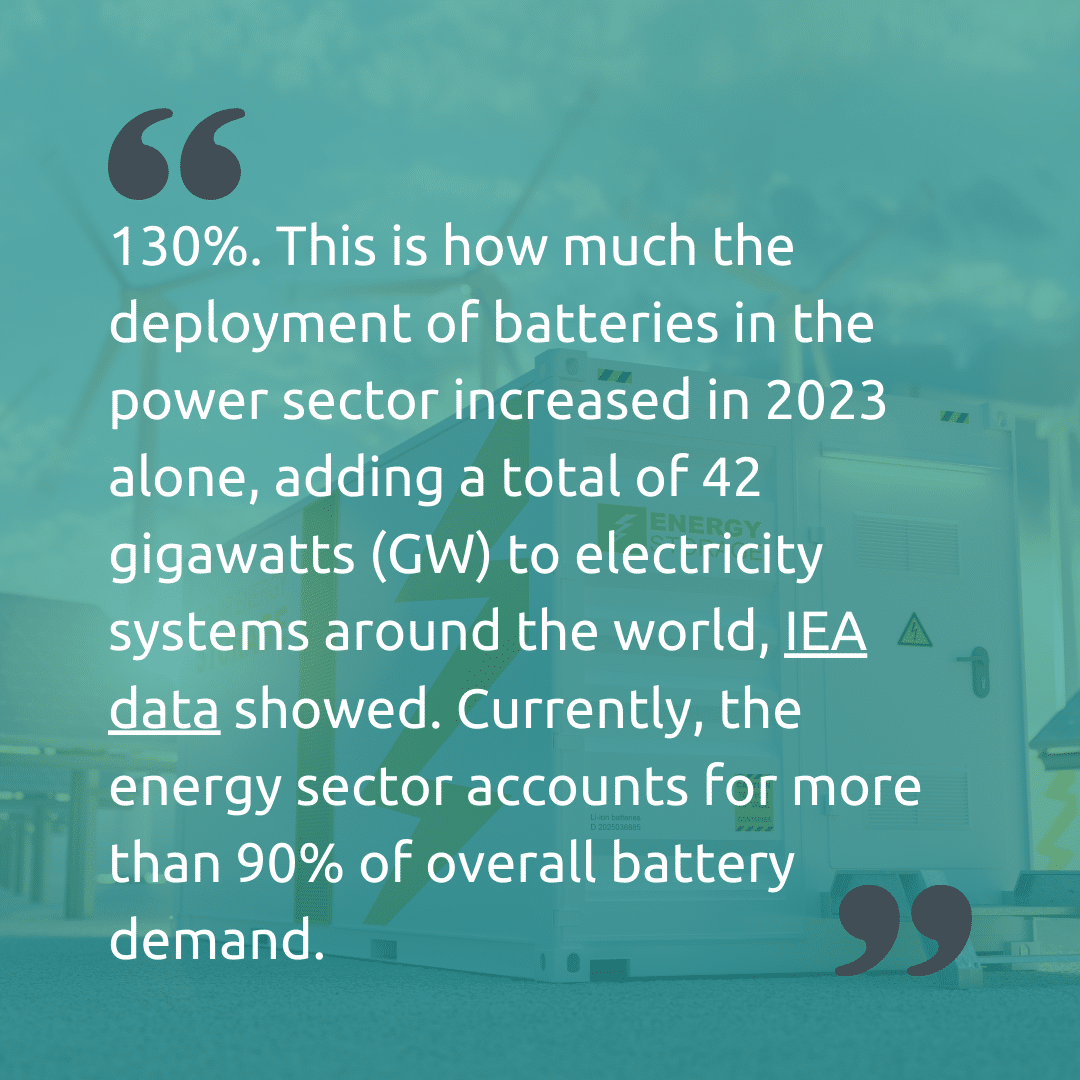Batteries play a crucial role in the global energy system today and are set to play a critical part in ensuring secure clean energy transitions. In the transport sector, batteries are especially significant, as they serve as the essential power source for the millions of electric vehicles (EVs) sold each year. In the power sector, batteries play an important part in providing access to electricity in decentralized solutions such as mini-grids and solar home systems.
As the world shifts towards reducing carbon emissions and dependence on fossil fuels, the role of batteries in enabling this transition—by powering EVs and storing renewable energy—is becoming even more significant. Their development and deployment will be key to achieving sustainable energy and climate targets globally.
In 2023, the growth of battery technology outpaced nearly all other clean energy technologies, according to a new report by the International Energy Agency (IEA). This surge was driven by a combination of falling costs, technological advancements, and supportive industrial policies, all of which boosted demand for batteries—a key technology essential for achieving the climate and energy targets set forth at the COP28 climate conference in Dubai.
This growth led to an increase in battery storage deployment, which more than doubled last year, reflecting the technology’s importance in supporting the integration of renewable energy sources into power grids and enhancing energy reliability. Battery electricity storage supports a wide array of services like frequency response and reserve capacity, black-start capability, storing power in EVs, upgrading mini-grids, and supporting self-consumption of rooftop solar power.
By storing energy generated from renewable sources, batteries ensure a continuous and stable supply of electricity, enabling communities to access clean energy even when the sun isn’t shining. This not only enhances energy security but also supports sustainable development by bringing electricity to regions that previously had limited or no access to power. In the long term, batteries have the potential to support very high levels of variable renewable energy.
Last year, battery storage emerged as the fastest-growing commercially available energy technology.
Let’s take a look at the entire battery ecosystem – from critical minerals and manufacturing to use, storage, and recycling – in numbers.
17.2 GWh. This is the quantity of the new battery energy storage system (BESS) installed in Europe in 2023, representing an impressive 94% increase compared to the previous year, according to the latest report from SolarPower Europe. By the end of last year, the region’s total operating BESS fleet reached approximately 36 gigawatt-hours (GWh). The residential segment was the largest contributor, accounting for 63% of this capacity. Large-scale battery systems followed with 21%, while commercial and industrial systems made up 9%. This distribution reflects the significant role of residential storage in Europe’s energy landscape, alongside growing contributions from large-scale and commercial applications.

130%. This is how much the deployment of batteries in the power sector increased in 2023 alone, adding a total of 42 gigawatts (GW) to electricity systems around the world, IEA data showed. Currently, the energy sector accounts for more than 90% of overall battery demand.
99%. Over the past 30 years, this is how much the cost of batteries has fallen. In the meantime, the density of top-tier cells has increased fivefold, according to the non-profit organization Rocky Mountain Institute (RMI). RMI added that for every doubling of battery deployment, costs dipped by 19%. Additionally, energy density has improved by 7% for each deployment doubling.
2,000 GWh. This is how much the global demand for batteries is expected to increase by 2030, from 185 GWh in 2020, according to Statista. This massive rise is primarily driven by the electrification of transport.
US$32-US$54 per kWh. Costs of batteries are expected to fall within this range by 2030 and top-tier density will be between 600 and 900 Wh/kg, RMI forecasts.
Over 2 million metric tons. The increase seen in global demand for graphite in battery anodes by 2028. Other key battery minerals like lithium and nickel needed for battery applications are also projected to register a rise in demand, Statista stated.
Between 50% and 60%. This is how much total installed costs of BESS could fall, driven by optimization of manufacturing facilities, combined with better combinations and reduced use of materials, according to a report by IRENA. The lifetime and performance of battery are also expected to see continued improvement, which will further reduce the costs of the services they provide. For stationary applications, lithium-ion battery costs are seen to fall below $200 per kWh by 2030 for installed systems.
€170 billion (US$187 billion). This is the amount forecast by the EU to be spent on digital technologies to upgrade European grids by 2030, according to an NTT Data report. Within this investment scenario, BESS emerged as a significant business opportunity. The integration of BESS into the grid modernization efforts is seen as a key component in enhancing grid reliability, supporting the integration of renewable energy sources, and improving overall energy management. The substantial investment in BESS reflects their critical role in enabling a more resilient and efficient energy system in Europe.
275MWh project. The largest approved BESS in Europe to date, claimed by developer Kyon Energy. The company received approval for a 137.5MW/275MWh BESS project in Germany, with construction expected to commence this year for commissioning by the end of 2025, according to Energy Storage News.
€12 billion (US$13.2 billion). This is the estimated added value from savings from large-scale battery storage systems on the wholesale market alone by 2050, Frontier Economics data showed. Large-scale battery storage systems can generate significant economic added value, which can be done by shifting the availability of electricity from periods of surplus to times of power shortage.
To read other articles we have on renewable energy, please click here.
Looking for a job in the Battery storage industry? Click here to apply now.





